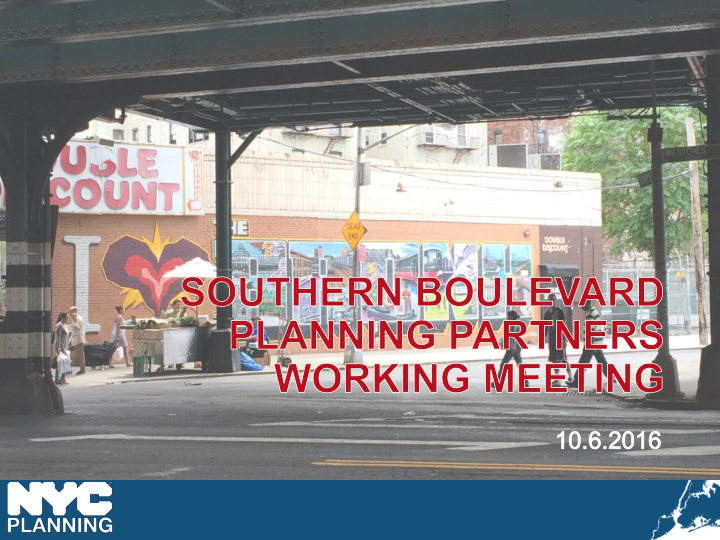



DRAFT
Age genda da Introductions What is a neighborhood study? What is the study area? What do you know? What’s missing? How should we engage the community? DRAFT 2
Age genda da Goals 1. Partners to share information about area and prior planning 2. Achieve some agreement on larger information gaps in study area 3. Determine process and style for public engagement DRAFT 3
Wh What is is a n a nei eigh ghborho hood od study dy? • DCP neighborhood studies are comprehensive planning processes that focus resources from many city agencies in the study area. It will include a robust community engagement process where the community will create goals and objectives. The result will include land use actions, capital investments, programmatic and service enhancements, and an implementation plan to achieve the goals of the study • As part of the Mayor’s Housing New York Plan, a key goal will be to increase and preserve affordable housing Each process will be tailored to meet the unique • needs of the community DRAFT 4
Wh What is is a n a nei eigh ghborho hood od study dy? A typical study process includes: Identify Develop Set Vision Gather Create Issues Strategies & Goals Information Framework DRAFT 5
Role of the Planning Partners 1. Share Knowledge of plans, studies, programs, local knowledge 2. Drive participation to public events, workshops, focus groups, etc. 3. Provide General Input on the planning process DRAFT 6
Why study Wh dy the e Southe thern rn Boule levard d area ea? • Studying the area around Southern Blvd implements the land use recommendations of the Sheridan Expressway – Hunts Point Land Use and Transportation Study. • There has been a lot of planning work and studies done in the area like CB3’s 197a Plan , the Crotona Park Master Plan, the Bronx River Greenway, WHEDco ’s retail studies, South Bronx Rising Together ’s work in education and youth development, and much more. • We will build off these studies and strong partners to create a unified vision for the future of the area • Many challenges face the area and would benefit from a focus of city resources DRAFT 7
What we’ve been hearing Affor ordable dable Housin ing Planning nning Fatigu igue Mix ix of In Income omes Quality Retail Seniors Health Jobs Ne Neighbor ghborhood hood to Stay Youth Music, Art, and Culture Shelters Transparency Cri rime me and nd Safety fety Fresh, Healthy Food Implem Im ementat entation ion DRAFT 8
Study dy Over ervie iew: Study dy Area ea • 58,814 residents • 1.09 sq. mi • 45,934 people per sq. mi. • 16 Census Tracts • 3 Community Districts • 1 City Council District • 2/5/6 Trains • Multiple bus routes • Large parks DRAFT 9
Study dy Over ervie iew: Dem emogra ograph phic ic Profil ile Percen enta tage ge under 25 years s old Study area: 43% 43% Bronx: 38% 38% NYC: 32% 32% DRAFT 10
Study dy Over ervie iew: Dem emogra ograph phic ic Profil ile DRAFT 11
Study dy Over ervie iew: Dem emogra ograph phic ic Profil ile CDs 2&3 lost 65% of population DRAFT 12
Study dy Over ervie iew: Med edia ian In Income ome DRAFT 13
Study dy Over ervie iew: Land U d Use an e and d Zo Zonin ing DRAFT 14
Planned ed Work k of Capi pital Age genci cies es in in t the st e study dy area ea DRAFT 15
What do you know? 1. What are the major goals and objectives of your plan? 2. How does it affect the proposed study area? DRAFT 16
What do you know about ut the stud udy y area? a? 1. Where is your organization located, the locations you service, and your entire catchment area? 2. What services or programs do you provide in the area? 3. What programs, capital work, or large events do you have planned? 4. What are the major goals and objectives of your plan? 5. What populations do you serve? DRAFT 17
What’s missing? What don’t we know / What’s missing? DRAFT 18
Public lic Engagemen agement t Process cess • Results of Survey • What’s Next We Are Here? Identify Develop Set Vision Gather Create Issues Strategies & Goals Information Framework DRAFT 19
Public lic Engagemen agement t Process cess Next Step: Public Meeting in early December • Recap of “What We Know” and “Issue Identification” • Visioning and Goal-Setting exercises • What else would make for a successful public engagement meeting? DRAFT 20
Recommend
More recommend